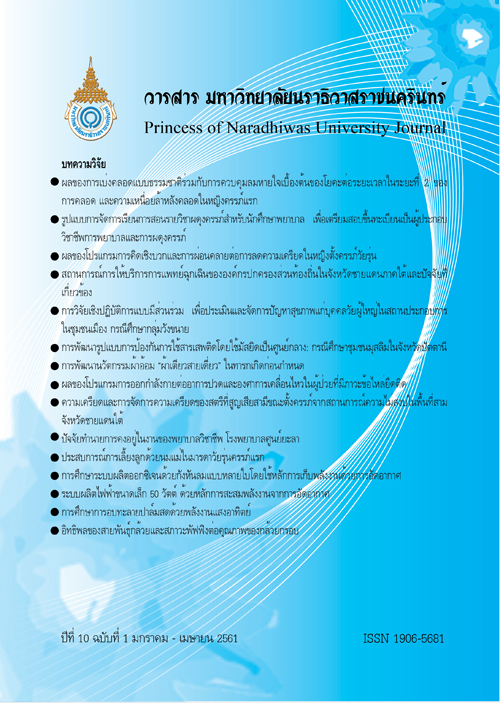สถานการณ์การให้บริการการแพทย์ฉุกเฉินขององค์กรปกครองส่วนท้องถิ่น ในจังหวัดชายแดนภาคใต้และปัจจัยที่เกี่ยวข้อง
คำสำคัญ:
การให้บริการการแพทย์ฉุกเฉิน, องค์กรปกครองส่วนท้องถิ่น, ภาคใต้บทคัดย่อ
การศึกษาเชิงพรรณนานี้ มีวัตถุประสงค์เพื่อศึกษา 1) สถานการณ์การให้บริการการแพทย์ฉุกเฉินขององค์กรปกครองส่วนท้องถิ่นในจังหวัดชายแดนภาคใต้ 2) ปัจจัยที่เกี่ยวข้องกับการให้บริการ ประชากร คือ ผู้บริหารขององค์กรปกครองส่วนท้องถิ่น (อปท.) ในพื้นที่จังหวัดชายแดนภาคใต้ ทั้งที่มีและไม่มีการจัดบริการการแพทย์ฉุกเฉิน เก็บรวบรวมข้อมูลโดยใช้แบบสอบถามเกี่ยวกับการบริหารจัดการและดำเนินการจัดบริการการแพทย์ฉุกเฉินขององค์กรปกครองส่วนท้องถิ่นตรวจสอบความตรงของเนื้อหาโดยผู้ทรงคุณวุฒิ 3 คน และวิเคราะห์หาค่าความเที่ยงของแบบสอบถาม โดยวิธีของคูเดอร์-ริชาร์ดสันใช้สูตร KR-20 ได้เท่ากับ 0.94 การวิเคราะห์ข้อมูล ใช้สถิติเชิงพรรณนา ได้แก่ การแจกแจงความถี่ ค่าร้อยละ ค่าเฉลี่ย ค่าส่วนเบี่ยงเบนมาตรฐาน ค่ามัธยฐาน พิสัยควอไทล์ และวิเคราะห์ปัจจัยที่เกี่ยวข้องกับการจัดบริการการแพทย์ฉุกเฉินขององค์กรปกครองส่วนท้องถิ่นในพื้นที่จังหวัดชายแดนภาคใต้ ด้วย Binary Logistic Regressionการศึกษานี้ ได้รับแบบสอบถามตอบกลับคืนมา จำนวน 273 แห่ง คิดเป็นร้อยละ 64.8 ผลการศึกษา พบว่า ประมาณครึ่งหนึ่งของกลุ่ม อปท. ที่มีการดำเนินการจัดบริการการแพทย์ฉุกเฉิน (ร้อยละ 53.5) มีนโยบายด้านการจัดบริการการแพทย์ฉุกเฉินและเขียนเป็นลายลักษณ์อักษร (ร้อยละ 73.3) และระบุว่ามีงบประมาณเพียงพอ (ร้อยละ 67.1) มีชุดปฏิบัติการแพทย์ฉุกเฉินเบื้องต้น (FR) เกือบทั้งหมด (ร้อยละ 94.5) และมีผู้รับผิดชอบงานหลัก (ร้อยละ 84.9) ส่วนการดำเนินการที่สามารถทำได้ตามมาตรฐานที่กำหนดไว้เกินกว่าร้อยละ 80 อันดับแรก ได้แก่ ความสามารถติดต่อระหว่างศูนย์รับแจ้งเหตุ/โรงพยาบาลเพื่อขอความช่วยเหลือ (ร้อยละ 94.5) รองลงมา คือ มีการรับแจ้งเหตุได้ตลอด 24 ชั่วโมง (ร้อยละ 93.8) ตามลำดับ ส่วนการดำเนินการที่สามารถทำได้น้อยที่สุด ต่ำกว่าร้อยละ 60 คือ การมีระบบนำทาง GPS ใช้งาน (ร้อยละ 20.5) ส่วนกลุ่ม อปท. ที่
ไม่มีการจัดบริการการแพทย์ฉุกเฉิน มีถึงร้อยละ 46.5 เนื่องจากงบประมาณไม่เพียงพอเป็นปัญหาที่พบมากที่สุด (ร้อยละ 81.9)
ส่วนปัจจัยที่มีความสำคัญมากต่อการเพิ่มโอกาสในการจัดบริการระบบการแพทย์ฉุกเฉินของ อปท. พื้นที่จังหวัดชายแดนภาคใต้
คือ 1) นโยบายด้านการจัดบริการการแพทย์ฉุกเฉินเป็นลายลักษณ์อักษร 2) งบประมาณในการสนับสนุนการจัดบริการการแพทย์ฉุกเฉิน และ 3) การให้ความสำคัญของผู้บริหาร ข้อมูลที่ได้จากการศึกษานี้สามารถนำไปเป็นพื้นฐานในการพัฒนาระบบบริการการแพทย์ฉุกเฉินในพื้นที่โดย อปท.ให้มีประสิทธิภาพมากขึ้น
เอกสารอ้างอิง
Keawnui, S. & Panasanachee, S. (2014). Statistics of the unrest in southern provinces by the year 2014:the least events in 11 years. Deep South Incident Database (DSID), Center for Conflict Studies andCultural Diversity (CSCD). Prince of Songkla University, Pattani Campus. Retrieved January 8,2013, from https://www.deepsouthwatch.org/node/6633. (in Thai).
Kraonual, S. (2008). Impacts of the Unrest Situation in the Three Southern Border Provinces on Health Care Service System. Retrieved September 24, 2014, from https://www.deepsouthwatch.org/sites/default/files/Sunee%20-%20HealthSystem.pdf. (in Thai).
Lacharojn, W. (2008). The Relationship Factor of Participation of Local Authorities or Organization for Emergency Medical System in Pathumthani Province. Khon Kaen Hospital Medical Journal, 32(7), 68-77. (in Thai).
National Institute for Emergency Medicine. (2011). Implementation of Emergency Medical Systems of Local Administrative. Bangkok: New Thammada Press.
National Institute for Emergency Medicine. (2013). Annual Report 2012 National Institute of Emergency Medicine. Bangkok: So.Phichit Printing. (in Thai).
National Institute of Emergency Medicine. (2014). The gap of Thai Emergency Medicine: Report Emergency Medical Service System 2013. Bangkok: NP Press.
Sangthong, S., Poonpunamnua, T., Suvakan, C., Ajhan, P., & Sawat Prasit, K. (2015). Report on quality assessment and compensation for emergency medical services 2015. Bangkok: Art Equit Limited. (in Thai).
Suriyapantri, M. & Chimkul, L. (2008). Local Government Participation in Emergency Medical Services in Nangrong District, Buriram Province. Research Results 2008 Provincial Health Office. Buriram: Provincial Health Office. (in Thai).
Suriyawongpaisarn, P., Srithamrongsawat, S., Hempisut, P., Aueasiriwon, B., Pholpark, A., Wannasri, A., & Bamrungkhet, W. (2013). The Emergency Management System of the Regional Emergency Medical System. Health Insurance System Research Office (HISRO). Health Systems Research Institute (HSRI). (in Thai).
Suwanarak, U., Suwannarak, S., Pappila, N., Kuhakarn, R.,Chusang, S., & Somton, A. (2015). The gap Emergency Medical Thailand: Report Emergency Medical Service System 2014. Bangkok: National Institute of Emergency Medicine. (in Thai).
Suwanarak, U., Suwannarak, S., Yuppipol, P., Kuhakarn, R.,Chusang, S., & Somton, A. (2016). The gap Emergency Medical Thailand: Report Emergency Medical Service System 2015. Bangkok: National Institute of Emergency Medicine. (in Thai).
Tienthavorn,T. (2013). Review of the development of the emergency medical service in Canada. International
Experiences on Emergency Medical Services. Health Insurance System Research Office (HISRO). (in Thai).
Wongthanavasu, S. & Sudhipongpracha, T., (2013). Analysis of the Capacity and Preparedness of Local
Administrative Organizations and Citizens in Health Management. College of Local Administration, Khon Kaen University. (in Thai).




